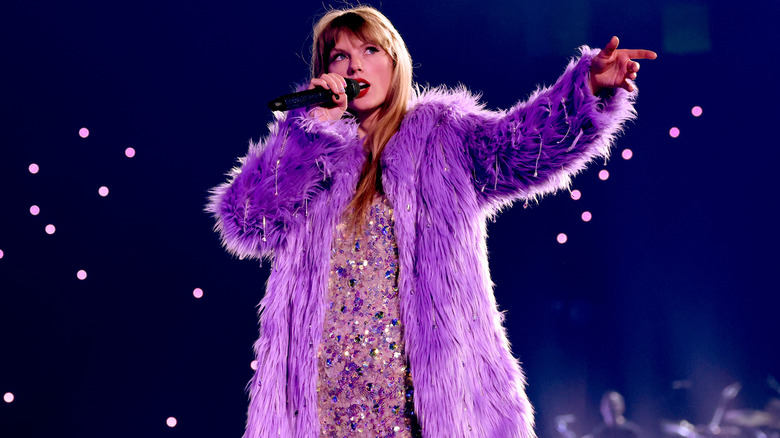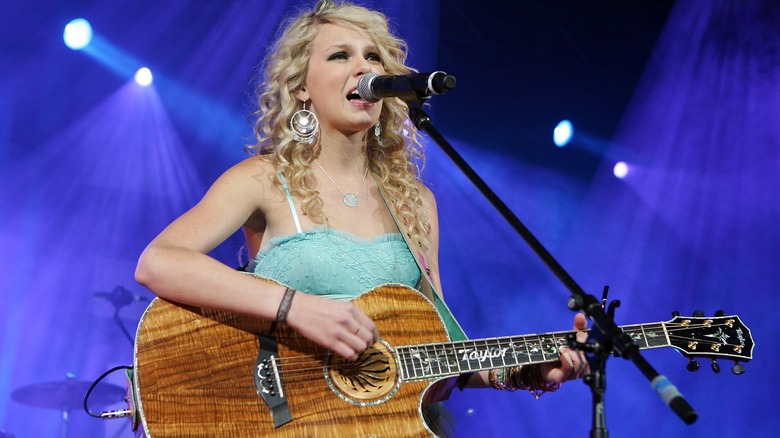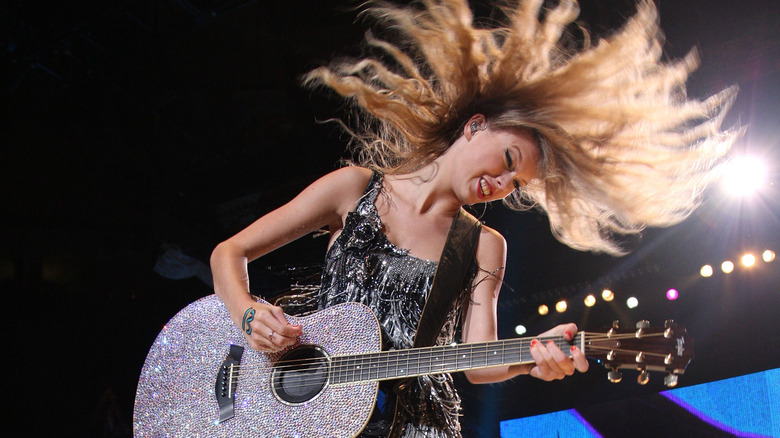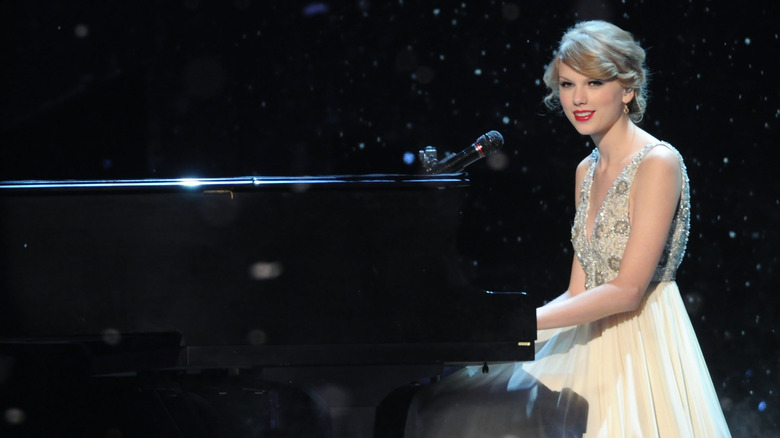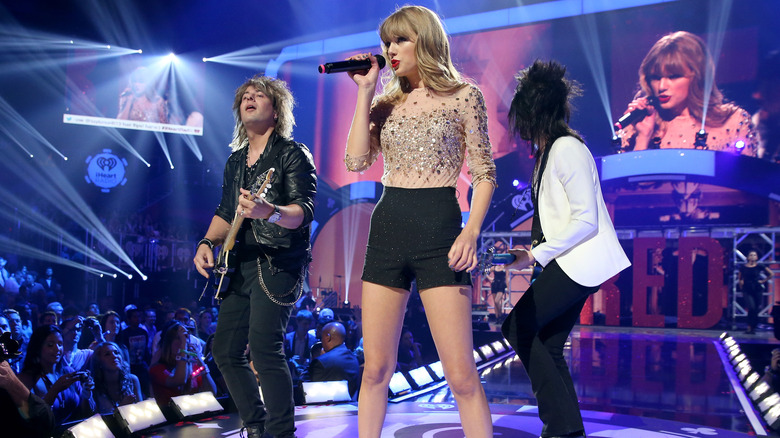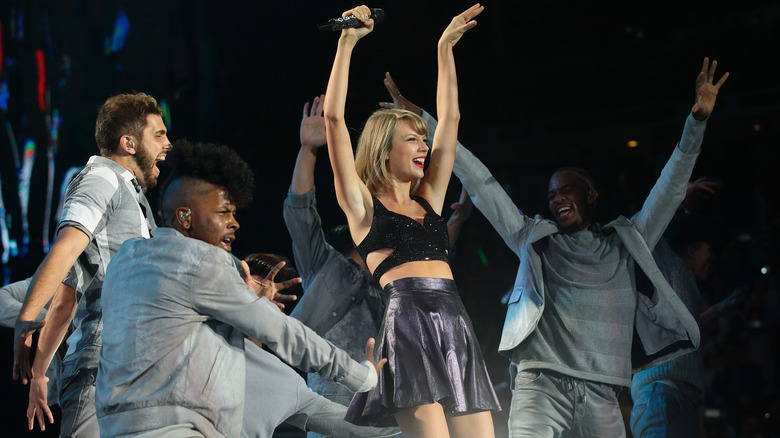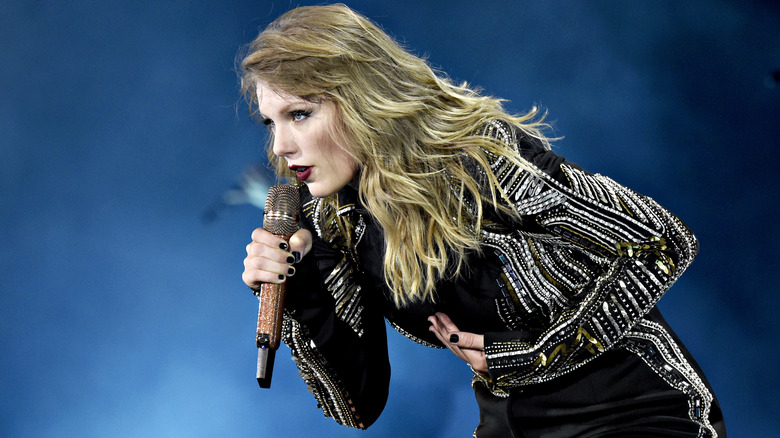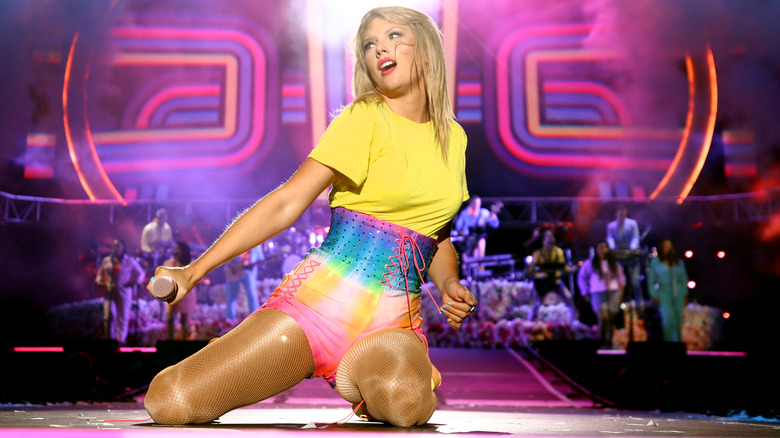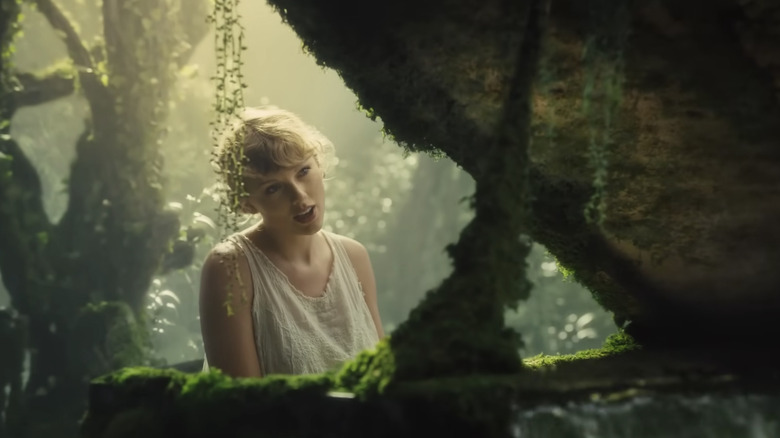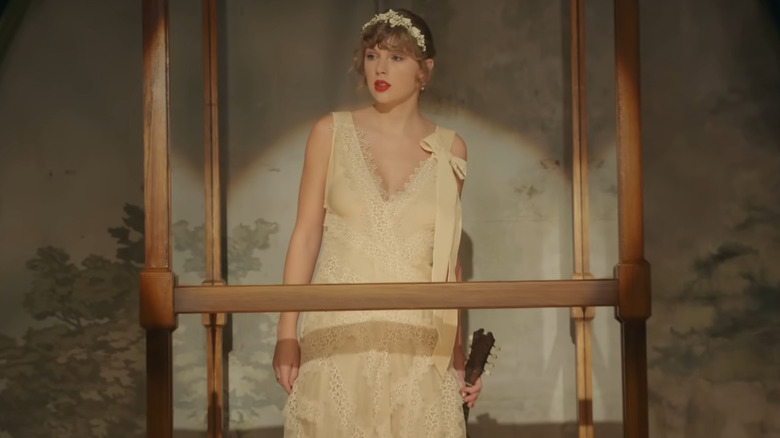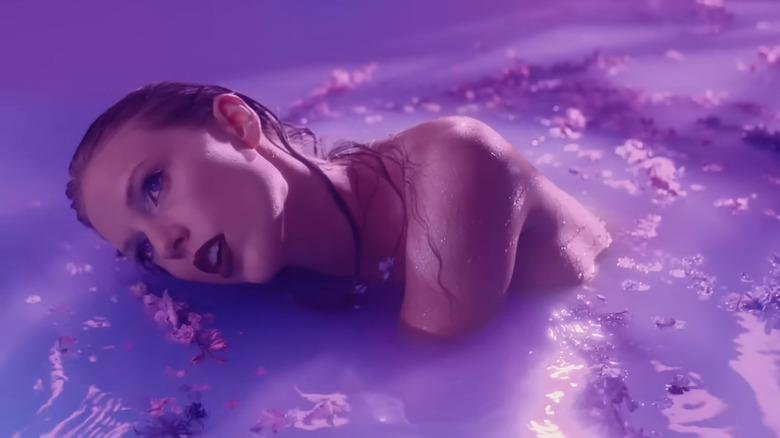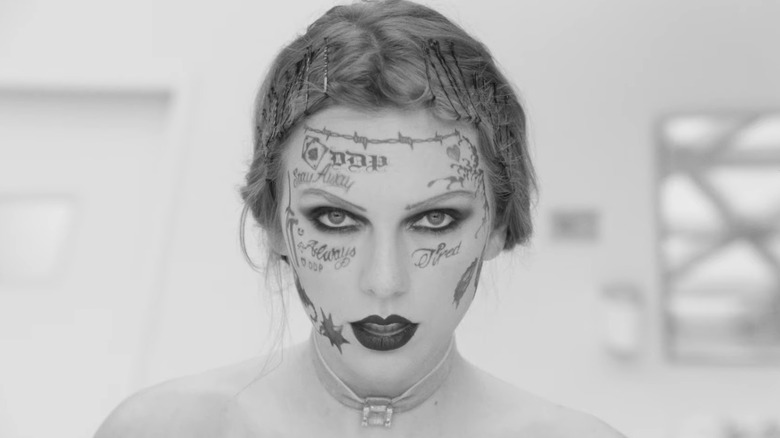Every Taylor Swift Era Explained
Taylor Swift is undoubtedly one of the most influential musicians of our time. She's been making headlines since the summer of 2006 when her debut single "Tim McGraw" was released and is still the center of attention two decades later. Since her debut, Swift has sold over 114 million albums and won 14 Grammys. With deeply personal lyrics rich with symbolism, her music speaks to humanity without the borders of age or gender. From a country pop darling to an indie pop icon, Swift's music has evolved through the years, providing cathartic entertainment that proves the haters wrong.
Millions of Swifties around the world recognize the attention to detail that goes into every Taylor Swift album. Each album marks the beginning of an era characterized by unique aesthetics that complement the concept of the album, Easter eggs, breathtaking visuals, and gorgeous outfits. (And, of course, there's Swift's complex dating history, which only adds to all the lore.) All this goes hand-in-hand with her magical voice and powerful songwriting to birth some of the most streamed albums in history. Whether you are a new or seasoned Swiftie, sometimes the task of remembering the details of every era can be more difficult than expected. Fret not, we have compiled brief explanations of every Taylor Swift era for your perusal.
Taylor Swift's debut album introduced the world to a country music darling
Ah, the era that started it all. The year was 2006, and a young aspiring country star named Taylor Swift entered the world of music with nothing but a guitar and some country attire. After years of performing in bars and venues in Nashville in hopes of getting a record deal, the singer-songwriter debuted her first and self-titled album, "Taylor Swift," at the mere age of 16. Soon enough, the young singer was opening for famous country acts like Rascal Flatts, Tim McGraw, and Faith Hill, all while having hits like "Teardrops on My Guitar" and "Tim McGraw" topping the charts.
The success of her debut album, of course, had Swift emerging into the music world as a teenage country darling, instantly recognizable by her tight blond curls, floral sundresses, and signature cowboy boots — and all of it coming together to form a monumental breakout era defined by Swift's country-chic style and sweet girl-next-door status. And who could forget her adorable country twang?
The Fearless era was full of sequins and teenage romanticism
With the release of her highly successful sophomore album "Fearless," the year 2008 had Taylor Swift beginning to emerge as a household name, with now-classic hits like "You Belong With Me" and "Love Story" quickly establishing the singer as a teenage country-pop icon. In fact, Swift even earned her first Album of the Year Grammy win for "Fearless," making history as the youngest-ever artist to claim the category at the age of 20 — until 18-year-old Billie Eilish broke her record in 2020.
As for what the iconic "Fearless" era was defined by, early fans will nostalgically recall the singer's sparkly dresses and ball gowns, signature winged eyeliner, hand hearts, and of course, Swift's lucky number 13, which the singer started donning on her hand for her performances during this era. "'Fearless' was an album full of magic and curiosity, the bliss and devastation of youth," Swift recalled in early 2021 (via Taste of Country). "It was the diary of the adventures and explorations of a teenage girl who was learning tiny lessons with every new crack in the facade of the fairy-tale ending she'd been shown in the movies."
Speak Now was Taylor Swift's most magical and theatrical era
Following the success of "Fearless," Swift set out to further prove herself as a rising star, and more specifically, as a talented songwriter. Her 2010 album "Speak Now" was her first (and only) self-written album, written entirely by herself without the help of co-writers. As noted by Pitchfork, it was a truly personal and confessional album that focused on that transitional period between "adolescence and adulthood, innocence and understanding, country and pop."
Much like the album itself (with songs like "Enchanted," "Sparks Fly," and "Long Live"), the "Speak Now" era was undoubtedly defined by its magical and theatrical aspects. In fact, Taylor Swift's ambitious Speak Now World Tour was inspired by Broadway and was a truly wondrous spectacle filled with pyrotechnics, lighted trees, dancers, aerialists, and multiple costumes and set changes. Ultimately, when you think "Speak Now," you'll probably think of Swift's sparkly dresses and looser curls, her "Wonderstruck" perfume line, and her ethereal "fairy tale" aesthetic.
The Red era saw Taylor Swift shifting into a more mature, experimental style
Think of the "Red" era, and you'll probably picture red lipstick and black fedoras — and of course, Taylor Swift's straight hair and blunt bangs. With the release of her 2012 album "Red," the singer debuted a new, edgier style, swapping out her usual glittery gowns for high-waisted shorts, striped shirts, and vintage dresses — and also famously ditching her signature bouncy curls for sleek, straight locks.
Swift's shift from her signature "princess fairy tale" aesthetics to a vintage, more mature style, of course, was also a reflection of her shift in sound and themes for her fourth album. According to NPR, "Red" in many ways represented a "turning point" in Swift's life and career while "on the precipice of adulthood," with the singer experimenting with different sounds beyond her previous country-pop style to touch on — and blend — new genres such as mainstream pop, rock, and even EDM and dubstep. "Musically and lyrically, Red resembled a heartbroken person," Swift reflected in 2021 (via NME). "It was all over the place, a fractured mosaic of feelings that somehow all fit together in the end. Happy, free, confused, lonely, devastated, euphoric, wild, and tortured by memories past."
The 1989 era established Taylor Swift as a global pop phenomenon
"1989" marked Taylor Swift's first full-scale pop album, and the era saw the singer taking over the music world as a worldwide mega-pop star, experiencing more commercial success than ever before. Few could escape the ubiquitous pop hits of "Shake It Off," "Blank Space," and "Style" from 2014 to 2015, and Swift's presence was felt pretty much everywhere, whether it be the radio or award shows. And who could forget Taylor Swift's "squad," aka the pop superstar's group of friends who were down to pop up in music videos or make surprise appearances at concerts.
Mirroring her transition from country to pop, the "1989" era was also defined by other Taylor Swift transformations. The award-winning songwriter moved to New York City, cut her hair into a short bob, and, of course, changed up her fashion style, opting for crop tops, skater skirts, and more form-fitting clothes that completed her evolution from a country sweetheart into a bombshell mega-pop star. Clearly, she was ready to shake off the eras of yesteryear.
Reputation was Taylor Swift's darkest and edgiest era yet
Following the peak of her career in the "1989" era, Taylor Swift found herself in the midst of bad press and negative public scrutiny — and it all started, of course, with her infamous feud with Kanye West and Kim Kardashian. After months of disappearing from the public eye, Swift made an iconic comeback in 2017 with her sixth studio album, "Reputation" — and needless to say, it was quite a different feel from any of her previous eras.
Declaring that "the old Taylor was dead" in her lead single "Look What You Made Me Do," the singer officially shed her "good girl" status and instead embraced the "snake" image put on her by the public. "Yeah, this is the character you created for me, let me just hide behind it," Swift told Vogue of the persona she created.
Reflecting the darker aspects of her electro-pop album, Swift's style during the unforgettable "Reputation" era was also noticeably edgier and grungier. Her classic red lip became darker and she rocked oversized sweatshirts, sequined bodysuits, and lots of thigh-high boots. And how could we forget "Bleachella" when she bleached her hair to an edgy platinum blond?
The Lover era was full of pretty pastels and bright, colorful optimism
Talk about a 180 from the "Reputation" era. Moving away from the dark and edgy style of her previous album, Taylor Swift ushered in her seventh era with the bright and cheery lead single "ME!," complete with a music video full of butterflies, rainbows, and colorful pastels. The noticeable shift in aesthetics also reflected the bright optimism of "Lover," signaling that the "old Taylor" perhaps wasn't dead, after all. "I've decided that in this life, I want to be defined by the things I love — not the things I hate, the things I'm afraid of, or the things that haunt me in the middle of the night," Swift wrote in the album's foreword. "Those things may be my struggles, but they're not my identity."
With this optimism of the "Lover" era came lots of brighter, more colorful looks in Taylor Swift's wardrobe — including lots of fringe, sparkles, pastel-colored menswear, and '70s-inspired clothes. There was also, of course, an abundance of the color pink — including in her hair, when she dyed the ends of her locks a pretty pink.
Folklore saw Taylor Swift embracing the alternative pop-folk genre
During the peak of the coronavirus pandemic, Taylor Swift announced the beginning of her alternative pop-folk journey by teasing us with the promotional images of her eighth studio album, "Folklore." The woodsy photographs in cottage core aesthetics saw the country-pop star's rise as an indie folk star. The emotionally intense album woven around folk storytelling also saw Swift drawing inspiration from other indie folk artists like Phoebe Bridgers, Sufjan Steven, and Lana Del Rey. The album also served with some dream collaborations like with Bon Iver for "Exile." Set in a grey-blue imagescape, the autumn-themed album released in the summer of 2020 is full of self-introspection rooted in melancholy taking her reputation as a confessional pop musician to new heights.
As Time magazine noted, "Every song [in the album] has these kinds of lyrical winks, reinforcing the universe that Swift has crafted even as she expands it with her newfound layers of fantasy and character." In a statement for the album, Swift shared that there is a collection of songs that she refers to as "the teenage love triangle."
"These three songs explore a love triangle from all three people's perspectives at different times in their lives," Swift noted. This statement has led fans to speculate that these songs are "Cardigan," "Betty," and "August." After all, when analyzed side by side, the songs weave a story of heartbreak, betrayal, and yearning — an embodiment of "the teenage love triangle."
Evermore cemented Taylor Swift's reputation as an indie artist
In December 2020, Taylor Swift made history by releasing the second album of her indie folk era, "Evermore" — the same year as "Folklore." With her ninth studio album, Swifties embraced the cottage core aesthetic and set out to solve the hidden puzzles in the album laden with mystical lyricism. Many parallels can be drawn between "Folklore" and "Evermore" and fans consider both albums part of one era. As noted by Teen Vogue, the music video for "Willow" can clearly be seen as a follow-up to that for "Cardigan" as both the videos begin and end in a wooden cabin.
Another interesting fact surrounding the winter-themed album is the co-writer of "Champagne Problems," "Coney Island," and "Evermore" — William Bowery. In her Disney+ film, "Folklore: The Long Pond Studio Sessions," Swift confirmed that Bowery is none other than her boyfriend Joe Alwyn, who had previously co-written "Betty" and "Exile" for "Folklore." This revelation saw Swifties taking to X, formerly Twitter, to joke about a happy couple role-playing a break-up scenario to give birth to relatable heartbreak songs.
Midnights era is full of paradoxes and futuristic retrospection
"Midnights," the 10th studio album is a collection of 13 songs Taylor Swift wrote on 13 different nights throughout her career and has elements of all the different eras. Listening to Midnights" is an experience of revisiting all her albums. On Instagram, she shared that the album featured "the stories of 13 sleepless nights scattered throughout my life." With "Snow On The Beach," this album also features a much-requested Taylor Swift-Lana Del Rey collaboration.
Even though "Midnights" was a surprise album, in less than 24 hours it became the most streamed album in a single day on Spotify, making Swift the most streamed artist in a single day on Spotify. The song titles of the album were revealed one by one via a cheeky TikTok series, "Midnights Mayhem With Me." The album also saw Swift going back to intensely personal lyrics, a trademark of her music after having stepped away from it for the last two albums. In retrospect, the album is also a great foundation for "The Eras Tour." There's no better way to re-engage with fans than giving them the musical treatment they've been patiently waiting for, right?
The Tortured Poets Department defied breakup album expectations
When Taylor Swift announced "The Tortured Poets Department," fans naturally assumed it would be a breakup album about Joe Alwyn. Ultimately, it's about Alwyn, yes, but it's also about her short-lived rebound romance with The 1975 frontman Matty Healy. Moreover, on songs like "But Daddy I Love Him," Swift hits back at her own fanbase, furious with those who meddled in her relationship out of a faux concern for her well-being. The more successful she's become, it seems, the more Swift views fame like a curse.
The night of the release, Swift wrote on Instagram, "An anthology of new works that reflect events, opinions and sentiments from a fleeting and fatalistic moment in time — one that was both sensational and sorrowful in equal measure." In other words, the songs on this album were written during a heightened emotional period; reflective and sad but also angry and spiteful.
The album's name turned out to be ironic. On the title track, Swift mocks a lover's typewriter, and she sings, "You're not Dylan Thomas, I'm not Patti Smith / This ain't the Chelsea Hotel, we'rе modern idiots." She knows just how overwrought her lyrics are — how tortured her poetry is — and the black and white visuals for lead single "Fortnight" match. She copies Post Malone's face tattoos and comes out looking like Jared Leto's Joker. If pop culture wants her to be a villain, then she'll assume the role ... at least for "The Tortured Poets Department" era.
